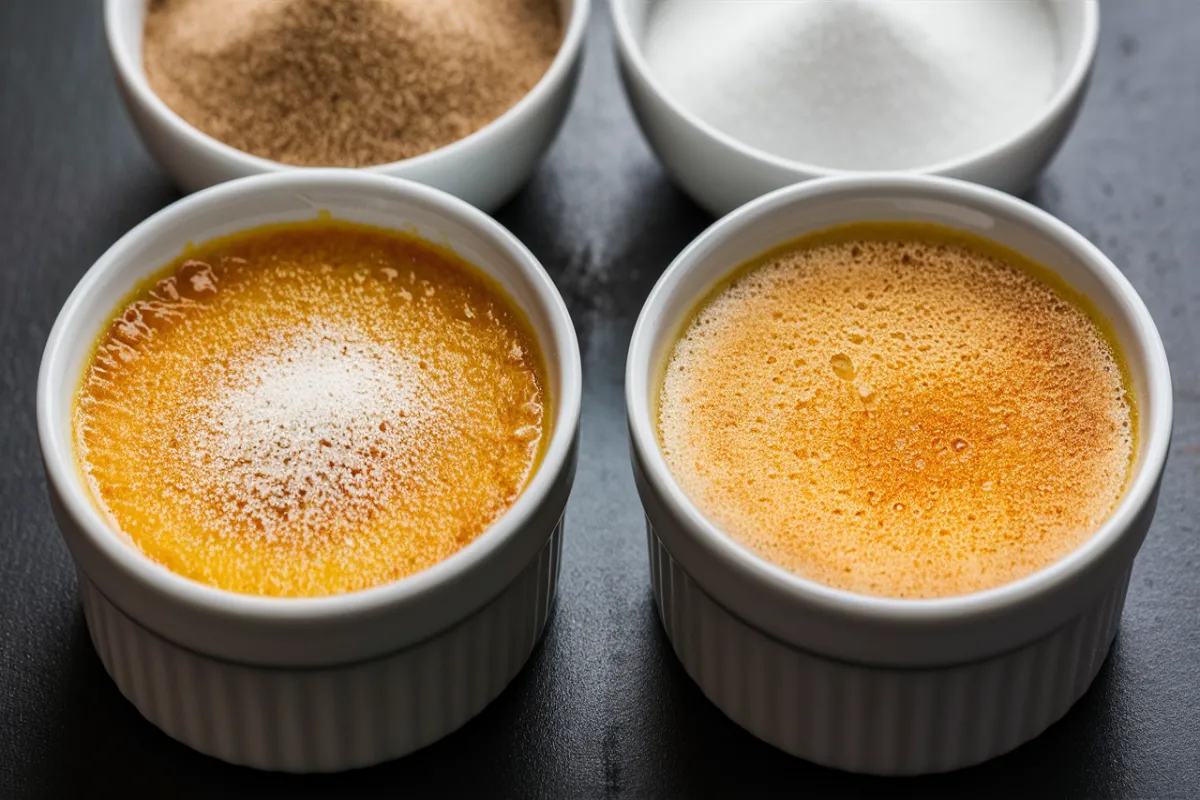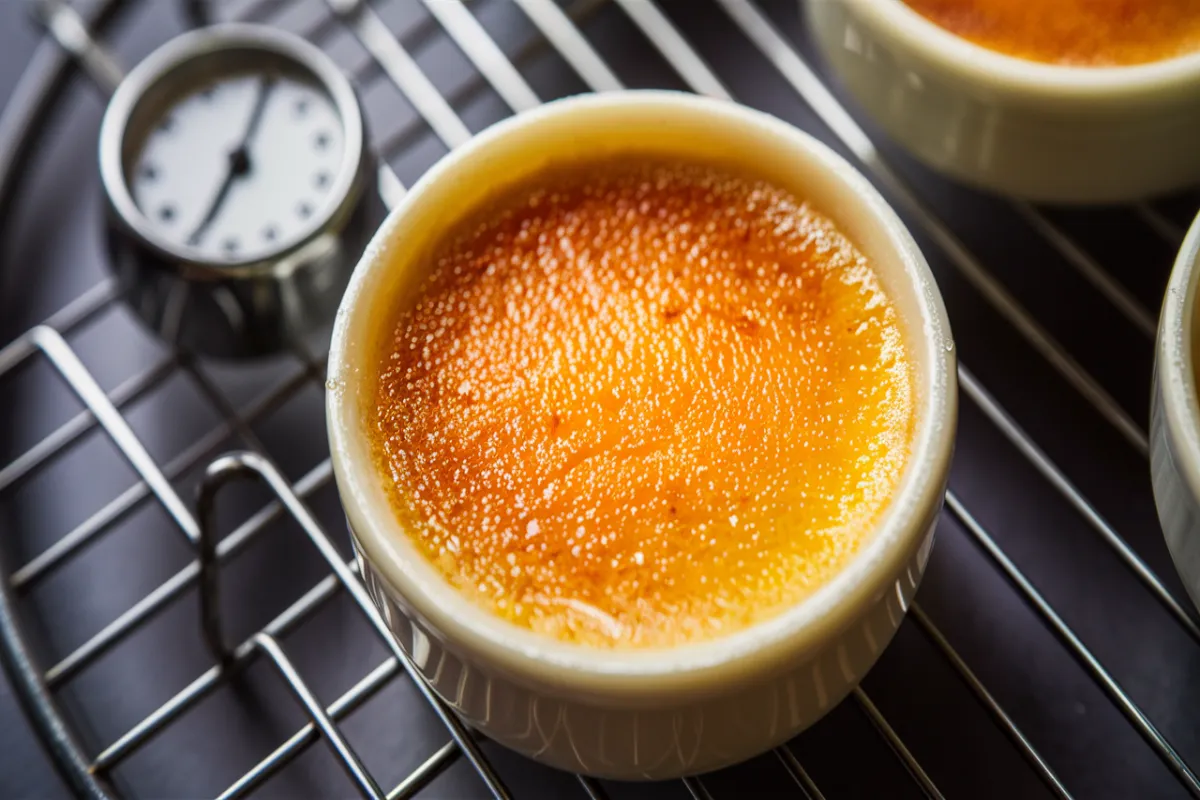Crème brûlée is a dessert loved for its creamy custard base and its signature caramelized sugar topping. The sugar you choose plays a crucial role in achieving that perfect, crackling crust. Whether you’re making crème brûlée for the first time or refining your technique, understanding which sugar to use can elevate your dessert to the next level. This comprehensive guide will explore the best sugars for crème brûlée, how they affect the final result, and tips for perfecting your brûlée.
1. The Importance of Sugar in Crème Brûlée
1.1 Why Sugar Selection Matters
Choosing the right sugar directly impacts the texture and flavor of your crème brûlée. The sugar forms the delicate, glass-like layer that cracks under the spoon. This topping contrasts with the smooth custard underneath, creating a delightful experience with every bite. The type of sugar you use determines how well it melts, caramelizes, and hardens, influencing the dessert’s overall appeal.
1.2 What Happens During Caramelization
Caramelization is the process where sugar melts and browns, developing rich flavors and a crisp texture. This reaction occurs when sugar is heated, causing its molecules to break down and form complex compounds. The sugar you choose should melt evenly and caramelize without burning. The goal is to achieve a golden-brown, brittle layer that cracks beautifully and enhances the custard’s flavor.
1.3 Balancing Sweetness and Texture
The right sugar balances sweetness with a crisp, delicate texture. Too much sugar can result in a thick, overly sweet crust. However, too little can create a layer that’s too thin and lacks the satisfying crack. The sugar should complement the custard’s subtle sweetness, adding a pleasant crunch without overwhelming the dessert.
2. Best Sugar Types for Crème Brûlée

2.1 Granulated White Sugar: The Classic Choice
Granulated white sugar is the most common choice for crème brûlée. Its fine texture allows it to spread evenly over the custard, ensuring uniform caramelization. When heated, granulated sugar melts smoothly and forms a clear, glass-like crust. This type of sugar also caramelizes quickly, making it ideal for achieving that golden-brown color without burning.
2.2 Superfine Sugar: For a Delicate Crust
Superfine sugar, also known as caster sugar, dissolves more easily than granulated sugar. This finer texture creates an even, delicate crust that melts and caramelizes quickly. Superfine sugar is particularly useful if you want a thinner, more refined topping. The smaller crystals spread easily and evenly, ensuring a consistent caramel layer with a smooth finish.
2.3 Turbinado Sugar: For Extra Crunch
Turbinado sugar is less refined than white sugar and has larger, golden-brown crystals. These crystals add extra crunch and a slightly molasses-like flavor to the brûlée topping. Turbinado sugar caramelizes more slowly due to its larger crystals, but it creates a thicker, more textured crust. This sugar is an excellent choice if you prefer a robust, crunchy topping with a hint of caramelized depth.
2.4 Demerara Sugar: A Richer Flavor Profile
Demerara sugar is similar to turbinado but has an even deeper flavor, thanks to its higher molasses content. The large crystals of demerara sugar add a rich, caramel-like taste to the brûlée. Demerara sugar caramelizes slowly, requiring careful attention during the caramelization process. The result is a flavorful, slightly chewy crust that adds complexity to the dessert.
Boost your productivity by improving your attention to detail at work
2.5 Brown Sugar: A Bold, Molasses Flavor
Brown sugar is often used to add a strong molasses flavor to crème brûlée. However, its higher moisture content can make caramelization tricky. Brown sugar creates a slightly softer, chewier topping compared to white sugar. If using brown sugar, consider blending it with granulated sugar for a balance between flavor and texture.
2.6 Blending Sugars: Combining for Texture and Flavor
Blending different sugars can offer the best of both worlds. For example, mixing granulated sugar with turbinado or demerara sugar combines the smooth caramelization of granulated sugar with the rich flavor and crunch of larger crystals. Experimenting with blends allows you to customize the brûlée topping to your taste, achieving a balance of sweetness, texture, and flavor.
3. Preparing Sugar for Caramelization
3.1 Measuring the Right Amount
The amount of sugar you use is crucial for achieving the perfect crust. Typically, one to two teaspoons of sugar per ramekin is enough. This amount creates a thin, even layer that caramelizes well without becoming too thick or overly sweet. Spread the sugar evenly over the custard to ensure consistent caramelization.
3.2 Evenly Spreading the Sugar
Evenly spreading the sugar is key to a uniform caramelized topping. Tilt and rotate the ramekin as you sprinkle the sugar to cover the surface completely. A thin, even layer prevents any sugar from burning or caramelizing unevenly. Avoid piling sugar in the center, as this can result in a thicker, harder spot that doesn’t crack as easily.
3.3 Adjusting for Different Sugar Types
Different sugars caramelize at different rates, so adjustments may be necessary. Granulated sugar and superfine sugar caramelize quickly, while turbinado and demerara sugars take longer due to their larger crystals. If using a coarser sugar, apply a slightly thicker layer and watch the caramelization process closely to avoid burning.
3.4 The Role of Moisture
Moisture on the custard’s surface can affect how well the sugar adheres and caramelizes. Before adding sugar, gently blot any moisture from the custard with a paper towel. This step ensures that the sugar forms a dry layer that melts and caramelizes evenly. If the custard is too wet, the sugar may dissolve before it can caramelize, resulting in an uneven crust.
4. Caramelization Techniques
4.1 Using a Culinary Torch: The Preferred Method
A culinary torch provides the most control when caramelizing sugar on crème brûlée. Hold the torch about 4 to 6 inches above the sugar and move it in small, circular motions. Start at the edges and work your way inward to ensure even caramelization. The torch allows you to caramelize the sugar without heating the custard underneath, preserving its creamy texture.
4.2 Adjusting the Torch Flame
Adjusting the torch flame is essential for achieving the right caramelization. A medium flame works best, providing enough heat to melt and caramelize the sugar without burning it. If the flame is too low, the sugar may melt unevenly or take too long to caramelize. If too high, it can burn the sugar quickly, leaving a bitter taste.
4.3 Caramelizing Under a Broiler: An Alternative
If you don’t have a culinary torch, you can use a broiler to caramelize the sugar. Preheat the broiler and place the ramekins on the top rack, close to the heat source. Keep the oven door slightly open to monitor the caramelization process. The sugar should melt and caramelize within 2 to 3 minutes. However, the broiler method can heat the custard, so it’s best to use a very cold custard base.
4.4 Avoiding Common Caramelization Mistakes
Several common mistakes can affect the quality of your caramelized crust. Holding the torch too close can burn the sugar, resulting in a bitter taste. Overcaramelizing the sugar can create a hard, burnt crust that’s difficult to crack. Additionally, uneven sugar distribution can lead to uneven caramelization, with some areas burning while others remain undercooked. To avoid these issues, move the torch constantly, use a medium flame, and ensure an even layer of sugar.
5. Enhancing the Flavor and Texture
5.1 Adding Spices to the Sugar
Enhance the flavor of your brûlée by adding spices to the sugar before caramelizing. A pinch of cinnamon, nutmeg, or cardamom can add warmth and complexity to the topping. Mix the spices with the sugar before sprinkling it over the custard. The spices will caramelize along with the sugar, infusing the brûlée with subtle, aromatic flavors.
5.2 Using Flavored Sugars
Flavored sugars offer an easy way to add depth to your crème brûlée. For example, vanilla sugar or citrus-infused sugar can introduce new flavors without altering the caramelization process. To make flavored sugar, mix granulated sugar with vanilla beans, citrus zest, or spices, and let it sit for a few days. Use this sugar to caramelize your brûlée for a unique twist on the classic dessert.
5.3 Combining Sugars for Different Textures
Combining different sugars can create a more complex texture and flavor. For instance, blending granulated sugar with a small amount of turbinado or demerara sugar adds crunch and a hint of molasses. This combination produces a topping that’s both smooth and textured, offering a more interesting contrast with the creamy custard.
5.4 Experimenting with Non-Traditional Sugars
Experimenting with non-traditional sugars can lead to exciting new flavor profiles. Coconut sugar, for example, adds a subtle coconut flavor and caramelizes to a deep brown color. Maple sugar offers a rich, earthy sweetness that pairs beautifully with the custard. When using alternative sugars, adjust the caramelization time to prevent burning, as these sugars may behave differently under heat.
6. Tips for Perfecting Your Crème Brûlée

6.1 Chill the Custard Thoroughly
Before caramelizing, ensure that the custard is thoroughly chilled. A well-chilled custard base helps prevent overheating during caramelization, keeping the texture smooth and creamy. Chill the custard in the refrigerator for at least two hours before adding the sugar. This step is especially important if using a broiler, as the custard is more likely to heat up during the process.
6.2 Avoiding Overcaramelization
Overcaramelization can lead to a burnt, bitter crust. To avoid this, keep the torch moving constantly and monitor the color of the sugar closely. The goal is to achieve a deep golden-brown color without letting the sugar turn too dark. If using a broiler, remove the ramekins as soon as the sugar has caramelized to prevent overheating.
6.3 Letting the Sugar Harden
After caramelizing, allow the sugar to harden for a minute or two before serving. This short resting period lets the sugar cool and form a brittle, crackling layer. Avoid refrigerating the brûlée after caramelization, as this can cause the sugar to soften and lose its crispness. Serve the brûlée immediately for the best texture.
6.4 Serving Crème Brûlée
Serve crème brûlée in shallow ramekins to ensure a good ratio of custard to caramelized sugar. The shallow depth allows for a larger surface area, providing more room for the caramelized topping. Pair the brûlée with fresh berries, a dollop of whipped cream, or a drizzle of fruit sauce to add contrast and enhance the dessert’s presentation.
7. Frequently Asked Questions
7.1 Can I Use Brown Sugar for Crème Brûlée?
Yes, you can use brown sugar, but it may create a softer, chewier topping. Blending brown sugar with granulated sugar can help achieve a better texture.
7.2 How Much Sugar Should I Use on Each Ramekin?
One to two teaspoons of sugar per ramekin is usually sufficient. This amount creates a thin, even layer that caramelizes well.
7.3 What If My Sugar Doesn’t Caramelize Evenly?
Uneven caramelization can result from an uneven sugar layer or inconsistent heat. Ensure the sugar is spread evenly and move the torch constantly to avoid this issue.
7.4 Can I Caramelize Crème Brûlée Without a Torch?
Yes, you can use a broiler as an alternative. Place the ramekins under the broiler and monitor closely to prevent burning.
7.5 How Do I Store Leftover Crème Brûlée?
Store leftover crème brûlée in the refrigerator, covered with plastic wrap. However, it’s best to enjoy the dessert fresh, as the caramelized sugar may soften over time.
Conclusion: Mastering Sugar Selection for Crème Brûlée
Choosing the right sugar for crème brûlée is essential for achieving the perfect caramelized topping. Whether you prefer the classic smoothness of granulated sugar, the delicate crust of superfine sugar, or the crunch of turbinado sugar, each option offers a unique texture and flavor. By understanding how different sugars caramelize and experimenting with various combinations, you can create a crème brûlée that’s perfectly tailored to your taste. With the right techniques and attention to detail, you’ll master the art of caramelizing sugar and delight in the satisfying crack of your crème brûlée’s golden crust.

